Best known for its Hawk jet trainer and Nimrod MRA4 surveillance aircraft, and for partnerships on the Eurofighter Typhoon and Lockheed Martin F-35 Joint Strike Fighter, BAE Systems is also carving a growing niche as a developer of unmanned systems.
While the bulk of this work is conducted by 600 staff at its Warton manufacturing site in Lancashire, the UK company also has expertise in two of its other self-styled "home markets" - Australia and the USA.
BAE Systems Australia can trace its work on unmanned air vehicle technologies back through products such as the Kingfisher and Brumby, with the former having been used to support trials for almost a decade. These have included testing a BAE-developed ground control station (GCS), and its imagery collection and exploitation (ICE) payload, which uses autonomy to reduce operator workload.
But BAE's entry into the North American UAV sector is more nascent, stemming from its recent acquisition of Tucson, Arizona-based Advanced Ceramics Research (ACR). Previously privately owned, the company employs around 60 people and has a UAV range including the Coyote, Manta and Silver Fox, plus GCS equipment and portable launchers.
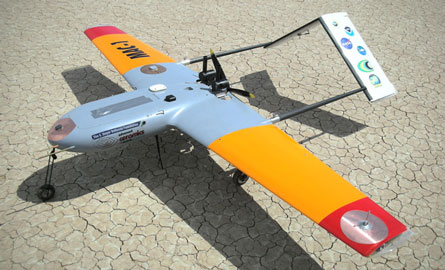 |
|---|
© H V Nguyen/Advanced Ceramics Research |
ACR's portfolio includes the Manta air vehicle |
Completed in June, ACR's acquisition as part of BAE Systems Inc for £9 million ($14 million) is in line with chief executive Ian King's strategy to grow BAE in home markets Australia, Saudi Arabia, South Africa, Sweden, the UK and the USA, and build in others, such as India and Japan.
The purchase also expands its unmanned product range from UK-developed systems including the Herti UAV and the Mantis and Taranis demonstrators.
BAE surprised many people in late 2005, when it lifted the lid on its development and trials activities with autonomous UAVs. Far from unveiling futuristic mock-ups, it detailed a more than three-year programme through which it had already secretly flown airframes named the Kestrel, Raven, Corax and Herti.
 |
|---|
© BAE Systems |
The Raven demonstrator first flew in 2003 |
The latter three designs were taken to Australia's Woomera test range for their flight campaigns, with BAE having already made one risk-reduction flight with its subscale Kestrel in the UK. The unmanned combat air vehicle-like Raven made its autonomous debut in December 2003, followed little over a year later by the surveillance-roled Corax.
While these systems were intended to demonstrate technologies such as autonomous control and operation, BAE from an early stage viewed the Herti - first flown in 2004 - as a viable product.
Derived from a manned glider produced by Polish firm J&AS Aero Design, the Herti has supported military trials for the UK Royal Air Force from Camp Bastion in Afghanistan, and more recently with the Royal Australian Air Force. BAE now has a stock of almost 20 of the aircraft, including fatigue test examples.
The first production-standard Herti was unveiled last year, as the first of three built by Slingsby Aviation. The new aircraft has a maximum take-off weight of 750kg (1,650lb), versus the previous design's 500kg limit, and carries a Cobalt electro-optical/infrared sensor from Sweden's FLIR Systems Polytech.
"We kept the other two behind the curtain as ready for conversion," says Andy Wilson, BAE's sales and marketing director for military autonomous systems (air), who adds that future production orders for the type "will probably go through the Slingsby route".
BAE had hoped to receive an urgent operational requirement (UOR) contract to again operate the Herti over Afghanistan, but this has failed to materialise. "At the moment, all we are doing is working with the RAF in case they want it," says Wilson. An entire system, including air vehicle, GCS, ground support equipment and spares can be deployed using a Lockheed Martin C-130 tactical transport.
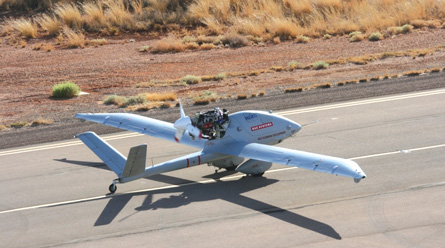 |
|---|
© BAE Systems |
Herti air vehicles are being tested in Australia |
Several Hertis were sent to Woomera earlier this year, and Wilson says these "will be flying quite a bit to get hours on, and to experiment with the day/night turret". New software "drops" will also be conducted while the airframes remain in South Australia.
Trials have also previously been conducted at Woomera using an armed development dubbed the Fury, with this equipped with Thales's new lightweight multirole missile. The UAV was unveiled at the Association for Unmanned Vehicle Systems International (AUVSI) North America 2008 convention in San Diego, California.
But the pending first flight of another new product is generating greater interest, with the milestone to advance BAE's Mantis UAV, revealed at last year's Farnborough air show.
To highlight the potential of a UK alternative to the General Atomics Predator B/Reaper, in RAF use over Afghanistan under a UOR deal, the concept demonstrator is nearing flight.
"The big drive behind Mantis is in delivering sovereign capability," says Wilson. A production version could fly at up to 55,000ft (16,800m) and perform missions including intelligence, surveillance, target acquisition and reconnaissance, and close air support.
A full-scale model of the current "Spiral 1" Mantis has been shown with a representative combat load of four Raytheon Systems Paveway IV 226kg (500lb) precision-guided bombs and two MBDA Brimstone-like air-to-surface missiles. Wilson describes the current air vehicle - which uses two Rolls-Royce RB250B-17 engines - as "a concept demonstrator with a viable mission system".
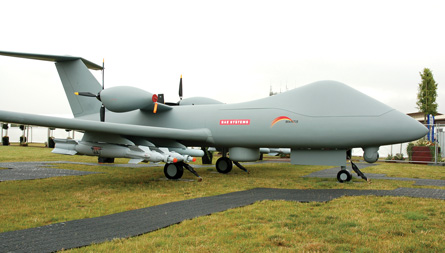 |
|---|
© Craig Hoyle/Flight International |
The Mantis will carry precision-guided weapons |
BAE's one Mantis has been in Australia since early this year, having originally been scheduled to fly in February. The assembled airframe has completed engine runs and is nearing the start of low-speed taxi trials.
Range availability at Woomera is among the driving factors that will determine the UAV's flight debut, but Wilson says: "We're not pinned to a contractual date to fly - we'll do it when we're all ready."
Mantis has twin payloads: an L-3 Wescam MX-20 HD electro-optical/infrared sensor and BAE's ICE. The Spiral 1 aircraft also has a "hardback" mounting on its fuselage side, which could be used later to accommodate a lightweight synthetic aperture radar from Selex Galileo.
Talks are already under way with regard to a "Spiral 2" air vehicle, with Wilson saying that BAE is "discussing the timing and the content with the MoD". The parties have funded the current work on a 50:50 basis since late 2007, but "for phase two it's envisaged that the majority of the funds will come from the MoD", he adds.
A production-standard aircraft would have a maximum take-off weight of around 8.5-9t; around twice that of the Reaper.
Keen to promote its UAV expertise to potential future buyers or industrial partners, BAE displayed a model of Mantis with an operational GCS at the Aero India 2009 show near Bangalore earlier this year, and cited New Delhi's "projected large requirement for unmanned aircraft systems".
The company recently secured a contract to conduct a technology demonstration for the RAAF, investigating topics such as autonomous target detection and recognition, on-board image processing and the use of simultaneous location and mapping techniques to reduce reliance on GPS guidance. The work will culminate with flights using a Kingfisher 2 UAV.
Meanwhile, the UK's Taranis UCAV demonstration programme will move forward next year, when a test vehicle will make its debut sortie, again in all likelihood from Woomera. Taranis is in final assembly at Warton, and recently achieved power-on. Ground testing with the aircraft, which weighs about 6t, is expected to start later this year.
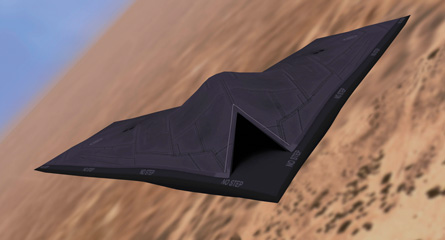 |
|---|
© BAE Systems |
The UK's Taranis UCAV demonstrator will fly in 2010 |
The UK MoD in 2008 launched a deep persistent offensive capability study into future UCAV systems, and has recently contracted R-R to investigate advanced propulsion and power generation technologies for such a system. Flight-test data from Taranis will play an important part in determining the viability of a future operational UCAV for the UK.
Other unmanned concepts being pursued by BAE include an adapted Rotorsport UK MT-03 autogyro named Ampesand, which is undergoing flight tests at Warton. The aircraft will be flown to its operating limits to collect flight-control data before being modified for autonomous flight. BAE believes a vertical take-off and landing UAV could fly autonomous surveillance missions from small ships.
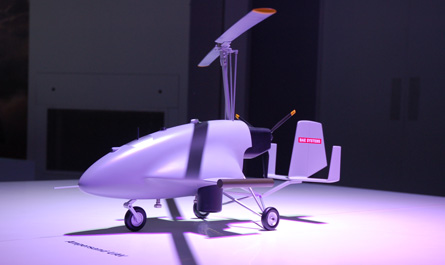 |
|---|
© Craig Hoyle/Flight International |
Ampersand could fly from naval vessels |
BAE is also working on a GA22 airship based on a design from Lindstrand Technologies. This could perform communications relay tasks, or carry surveillance equipment weighing up to 150kg during disaster relief operations or during major sporting events.
The latter theme represents a potential opportunity for BAE, with London to host the Olympic Games in 2012. The company has also provided marketing images of its Herti in the markings of a UK police force, and is involved in the Astraea initiative, which should demonstrate the safe operation of UAVs in non-segregated airspace by 2012.
BAE's autonomous systems activities are not restricted to the air environment, with other products such as the Black Knight and Hero land vehicles, the Land Rover-based Wildcat technology demonstrator and the Talisman unmanned underwater vehicle also in its portfolio, some of which will be on view at the AUVSI show in Washington, DC from 10-13 August.
Source: Flight International
















